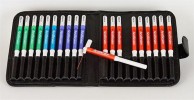Authors
Z Cai, G Lei, J Li et al
Lab
Department of Hand Surgery, Huashan Hospital, Fudan University, 12# of middle Wulumuqi road, Shanghai, 200040, China
Journal
Brain and Behavior
Abstract
Backgrounds:Objective: To investigate the role of central plasticity in sensory recovery after contralateral C7 nerve transfer. Methods: Sixteen right TBPI patients who received contralateral C7 nerve transfer for more than 2 years were included. Sensory evaluations included Semmes– Weinstein monofilament assessment (SWM), synchronous sensation test, and sensory evoked action potential (SNAP) test. Smaller value in the SWM assessment and larger amplitude of SNAP indicates better tactile sensory. Functional magnetic resonance imaging was performed while stimulations delivered to each hand separately in block-design trials for central plasticity analysis.
Results: The SWM value of the injured right hand was increased compared with the healthy left side (difference: 1.76, 95% confidence interval: 1.37–2.15, p < .001), and all 16 patients developed synchronous sensation. In functional magnetic resonance imaging analysis, sensory representative areas of the injured right hand were located in its ipsilateral S1, and 23.4% of this area overlapped with the representative area of the left hand. The ratio of overlap for each patient was significantly correlated with SWM value and SNAP amplitude of the right hand.
Conclusion: The tactile sensory functioning of the injured hand was dominated by its ipsilateral SI in long-term observation, and its representative area largely overlapped with the representative area of the intact hand, which possibly reflected a key mechanism of synchronous sensation in patients with TBPI after contralateral C7 transfer
BIOSEB Instruments Used:
Von Frey Filaments (Bio-VF-M)

 Douleur - Allodynie/Hyperalgésie Thermique
Douleur - Allodynie/Hyperalgésie Thermique Douleur - Spontanée - Déficit de Posture
Douleur - Spontanée - Déficit de Posture Douleur - Allodynie/Hyperalgésie Mécanique
Douleur - Allodynie/Hyperalgésie Mécanique Apprentissage/Mémoire - Attention - Addiction
Apprentissage/Mémoire - Attention - Addiction Physiologie & Recherche Respiratoire
Physiologie & Recherche Respiratoire
 Douleur
Douleur Système Nerveux Central (SNC)
Système Nerveux Central (SNC)  Neurodégénérescence
Neurodégénérescence Système sensoriel
Système sensoriel Système moteur
Système moteur Troubles de l'humeur
Troubles de l'humeur Autres pathologies
Autres pathologies Système musculaire
Système musculaire Articulations
Articulations Métabolisme
Métabolisme Thématiques transversales
Thématiques transversales SFN2024: Venez rencontrer notre équipe sur le stand 876 à Chicago
SFN2024: Venez rencontrer notre équipe sur le stand 876 à Chicago 